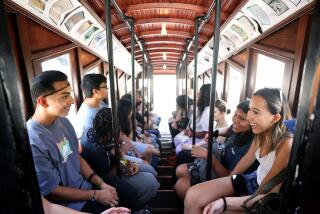Over Dim Sum, They Study Asia
Facing the first dim sum cart of his life, David Saeger, 18, paused. He had no clue that a cluster of snowball-shaped buns contained barbecued pork, much less how to name them after just one week of Chinese language classes. Finally, he decided to improvise.
“Nage,” he told a smiling waitress at the Empress Pavilion in Los Angeles’ Chinatown. “That one.”
That emboldened classmate Linda Chamberlin, also 18. “Liang ge,” or “two of that,” she said, pointing to a couple of beef dishes.
With their Mandarin-language professor’s help, the students soon had their table supplied with steamed dumplings, shrimp rolls and pastries filled with bean paste. The students grinned with delight--and self-consciousness.
“It’s just odd,” Saeger said. “I feel so out of place and stupid.”
But he did want to be there--which is why he enrolled in USC’s new Explore East Asia program. The classes are designed to enhance knowledge of Asia for undergraduates who are not necessarily majoring in the subjects related to the area. A free trip to China will cap the yearlong experience for the 10 students enrolled this year, while students completing the program over the next two years will go to Japan and Korea.
The program was launched with a $2-million grant this year from the Freeman Foundation, a nonprofit organization based in Stowe, Vt., which seeks to deepen Americans’ appreciation of Asia.
Houghton Freeman, the foundation’s president, said USC’s Explore East Asia program “does much in its way to help us achieve our mission.”
For Sean O’Connell, it took a book of Japanese fiction, “Monkey Brain Sushi,” to get him interested in East Asia during his college years. Now, a decade later, he is academic coordinator of USC’s East Asian languages and cultures department, which sponsors the program.
“People tend to look inwardly at themselves,” he said. “We’re trying to get people involved in Asia and away from Eurocentric tendencies. The more they learn about someone else, the more they can improve themselves.”
One of Explore East Asia’s attractions is that students don’t have to pay for the classes, worth about $11,000 a year. The free trip across the Pacific doesn’t hurt, either.
This year’s 10 scholars spent four intense weeks in July and August studying Chinese. They will take another course on China or the language during the school year. In May or June, they will travel to China for five weeks of immersion learning.
The students will probably visit Beijing, Shanghai and Xian and possibly Taiwan, O’Connell said. They’ll take a course at the same time, possibly in Chinese politics.
When they return, they will teach related four-week courses in the fall at Los Angeles high schools on such subjects as politics, history and culture. The goal is to guide other young minds toward East Asia.
The USC students are admitted to Explore East Asia only if they have had no prior college-level coursework in Asian languages or culture and cannot speak the languages fluently. Although about two-thirds of USC students in other classes offered by the languages and cultures department have East Asian ethnic backgrounds, only two of the 10 in the Explore East Asia program do.
They are students like USC freshman Chris Grunenwald, 18, from Merrill, Wis., who can’t recall a single Asian American in his high school graduating class of about 300. There’s freshman Saeger, of La Canada Flintridge, whose primary interaction with Asia had consisted of a popular Japanese video game. There’s Chamberlin, of Seattle, whose high school barely touched on Asian history, and Hooman Kazemi, 20, of Los Angeles, who speaks Spanish and Persian and thought Chinese would help with his international relations major.
And there’s freshman Eve Kan, 18, of Lewisville, Texas, and sophomore Melanie Cheng, 19, of Rolling Hills Estates, Chinese Americans who never learned their ancestral language.
Five days a week this summer, these students crammed into Room 221 of the Mark Taper Hall of the Humanities and stared at the blackboards containing Chinese characters chalked in white and orange. On one day, their spirited professor, Zoe Wu, holding flashcards labeled “tea” and “soda,” urged them to speak the words in Mandarin.
The program meant packing three hours of Chinese study into a day--equivalent to one week of classes during a normal schedule--and six or seven hours of homework. It meant taking four quizzes, two tests and one midterm exam in a week. It meant sore fingers after writing 500 Chinese characters a day.
“I think I’m getting carpal tunnel syndrome,” Saeger quipped.
In the classroom, Wu spoke almost exclusively in Mandarin. She launched into dialogues with students, introducing new words and phrases. “Ni xihuan bu xihuan cha?” she asked the students, inquiring if they like tea.
“Wo xihuan cha,” Kan answered in the affirmative.
Wu also pushes her students to converse with one another in Mandarin.
The students speak carefully, knowing that stressing the wrong syllable could skew their intended meaning. When Wu called for a rare five-minute rest, a collective sigh broke out. “Now is the hardest,” Wu said. “They’re learning everything from scratch.”
But the frenzied pace also brought the students a measure of delight as they discovered that they understood some storefront signs in Chinatown during their recent dim sum outing. And it resulted in the satisfaction of being able to order food in Chinese at a Chinese restaurant.
The trip to China will offer students a chance not only to study language, but “what goes behind the meaning of language,” said Dominic Cheung, department chairman.Dim sum, for example, in addition to describing small plates of Chinese dumplings and food, literally means “a bit of the heart,” which alludes to a kind of Chinese hospitality, Cheung said.
When the USC students visit Chinese universities next spring, Cheung said, they’ll find out firsthand what “Chinese courtesy” means.
“When you go off and explore, that’s when you’ll really learn,” O’Connell told the students over dim sum. “It’s limitless.”






